Cradock is a small town with a lot to see and enjoy in a small space. This makes it easy to take a slow stroll around town and see the sights. This saunter does not include attractions specifically mentioned elsewhere.
A good central point to begin is in the heart of town at the intersection of Church Street and Stockenstroom Streets. where you will find the :
Dutch Reformed Church (GPS: 32° 10' 9.82" S / 25° 37' 2.29" E)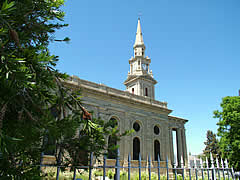
The first Dutch Reformed congregation was established in 1824 and was the first church in Cradock. The well-known President of the Transvaal Republic, Paul Kruger, was christened (by a Welsh pastor) in this church in 1826 and his name appears in the register.
The present building, the "Moederkerk" (mother church), was completed on the same site as the first church in 1868, 10 years after the town received it’s name.
The design of the church was based on St. Martins-in-the-Field, Trafalgar Square, in London. At the opening ceremony, attended by thousands of people, the builder refused to hand over the door keys until certain contract monies had been paid. This dilemma was solved by hurriedly appealing to the masses for assistance, by donations. Only part of the outstanding monies were collected, but the builder was satisfied, and the ceremony continued. Apparently the church had cost £24 500.
During the Anglo-Boer War the church roof was used as a lookout post by the British troops who garrisoned the town.
Opening hours: Mondays – Fridays: 09:00 – 12:00 (please call to confirm)
Contact: Church Warden – Mr. de Vos – Tel: 048 881 1251 or 082 420 6306
From the front of the church, walk south of Stockenstroom Street. Notice the clean and graceful lines of the Cradock municipal offices on the other side of the road. When you get to the next intersection at Voortrekker Street follow the road left as far as the next intersection which is Market Street. Cross over and enter :
Market Street (GPS : 32° 10' 14.28" S / 25° 37' 7.10" E)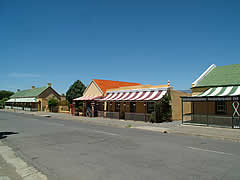
This part of the street, starting at the Victoria Manor hotel, is perhaps better know as Die Tuishuise and is a wonderful throwback to mid Victorian times. Most of the buildings in the street have been carefully restored to their original appearance.
Originally these houses were occupied by craftsmen who worked on wagons and with horses before the advent of the motor car.
Return to Voortrekker Street and turn right and then first left into Frere Street. Walk along Frere Street and at the corner with Durban Street you will come to :
The Horse Trough (GPS : 32° 10' 6.79" S / 25° 37' 7.78" E)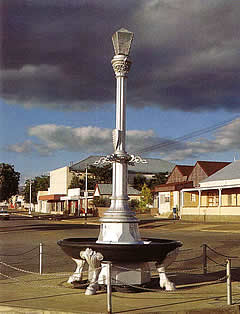
Cradock being a market town, farmers and other travellers would need to refresh their horses after the journey to town. This drinking trough was erected for the purpose in 1902 to commemorate the coronation of King Edward VII and is a fine example of what was once a common sight in such towns.
Continue on Frere Street as far as Albert Street and turn left. Turn right into Stockenstroom at the second intersection and continue until you reach the town cemetery. Here you can see two graves of interest :
Dr Reginald Koettlittz's Grave(GPS : 32° 9' 33.95" S / 25° 36' 49.50" E)
The famous geologist Dr. Reginald Koettlitz was the senior medical officer with Captain R.F. Scott’s first expedition to the Antarctic on the "Discovery" in 1905.
Shortly thereafter, he settled in South Africa and started a practice in the Somerset East district.
On the 10th of January 1916 both he and his wife died in Cradock, she of heart disease and he, a few hours later, of dysentery. They are both buried near the southern entrance to the cemetery. The inscription on his gravestone reads "Here lies Reginald Koettlitz, explorer and traveller, surgeon and geologist of expeditions North Polar and Abyssinia and with Scott to the Antarctic". (Open to the public during the day)
The other grave of particular interest may come as a surprise :
Harry Potter's Grave (GPS : 32° 9' 33.44" S / 25° 36' 50.11" E)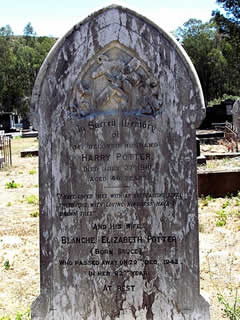
This grave was apparently discovered by a German who goes around the world in search of graves of famous personalities.
The tombstone reads: “In Sacred Memory of Harry Potter – died July 27 1910. Aged 47 years. I have loved thee with an everlasting love, therefore with loving kindness have I drawn thee.”
Buried with him is his wife Elizabeth Potter (born Bruce). She passed away on 29 December 1942 in her 82nd year. According to genealogist Duncan Ferguson this Potter descends from the 1820 Settlers and has another relative buried in Alicedale.
Leave the cemetery, return to the intersection with Albert Street and turn right. The town park is now on your right. Prominent next to the road is the :
Jurie Lombard Watermill (GPS : 32° 9' 54.51" S / 25° 36' 51.60" E)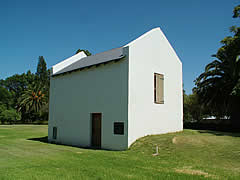
When the first Dutch Reformed Church in Cradock was demolished in 1862 the yellowwood from it was used in the construction of a watermill on the farm Lombardsrus. This mill continued to operate until 1928.
In the 1970’s the derelict mill was donated to the Cradock Foundation and with the assistance of the engineering department of the Municipality was housed in the present purpose-built building in the town park.
Thus, although the building itself and the present location are not authentic, all the workings and machinery are the original. (For more information about the Jurie Lombard Watermill click here).
A few metres away is the memorial to :
The Cradock Four (GPS : 32° 9' 55.17" S / 25° 36' 50.44" E)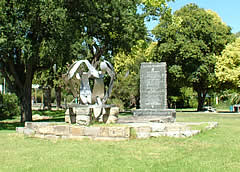
This is a memorial to some of the casualties of the A.N.C.'s struggle.
From the memorial continue down Albert Street a few meters and then cross over the road into Dundas Street. Along here at No 22 you will find :
The Cradock Club (32° 10’ 07.09” S / 25° 36’ 54’32” E)
This building was erected about 1850 and became the Cradock Club in 1881, the same year the railway line reached Cradock from Port Elizabeth.
During the Anglo-Boer War the club was used as the officers' mess of the Sherwood Forresters. At the end of the war, out of gratitude for the use of the premises, they donated their Burmese Teak dining room table, 12 chairs and writing table to the club.
This acquisition is today still in mint condition and is priceless. It stands in the club's reading room.
In the front garden of the club stand two Quercus Ilex Oak trees reputed to be among the oldest in the world. These were planted in 1850 by Mr. Charles Scanlen, a relative of the first mayor of Cradock.
Opening hours: Mondays – Fridays: 11:30 – 13:30 and 16:00 – 20:00
Saturdays: 11:00 – 15:30
Contact: barman at club – Tel: 048 881 2889
Continue down Dundas Street, turn left into Church Street andyou will find yourself back where you started.